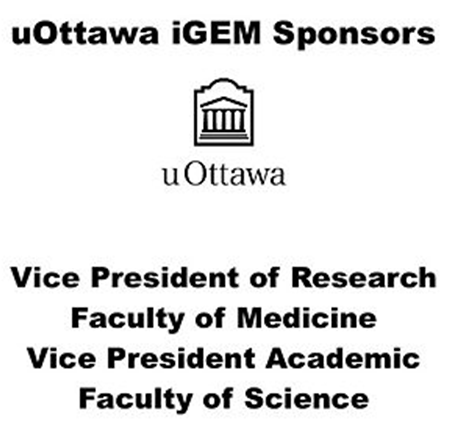Team:uOttawa/Safety
From 2011.igem.org
(Prototype team page) |
(→Safety) |
||
| Line 48: | Line 48: | ||
==Safety== | ==Safety== | ||
| - | + | 1. Our project would not raise any serious concerns about researcher safety. We worked with standard strains of Escherichia coli and Saccharomyces cerevisiae, which are non-pathogenic. Lab coats, safety goggles, and biological grade gloves were used whenever manipulating biohazardous materials. There were no concerns about public safety, since the strains were safe, and since we constructed simple gene networks which would not be able to do harm if they were taken up by a bacterium in the wild. There were no environmental concerns, as all used reagents were disposed of in accordance with our laboratory’s standard procedure. | |
| + | 2. No safety issues were raised by any of our parts and devices. We plan on submitting promoters, repressors, activators and terminators for S. cerevisiae, which are not dangerous. The cassettes for drug resistance, however, could increase resistance in bacterial populations against antibiotics if they were uptaken. We did not document this in the registry, as it seems to be a common issue. To deal with this safety concern, we were careful not to allow the resistance cassettes to be in a position where they could be taken up by bacteria in the wild. | ||
| + | 3. We do not have a biosafety group at our university. The Government of Canada has issued a lengthy set of guidelines pertaining to biosafety (http://www.phac-aspc.gc.ca/publicat/lbg-ldmbl-04/index-eng.php). Our lab falls under the first containment level, meaning that no special design and practice features are necessary as we are not working with organisms which are dangerous if ingested or airborne. The sections of the guide dealing with recombinant DNA and genetic manipulation state that most recombinant DNA work is safe, but containment level and pathogenicity should be considered. Containment level is addressed above, and none of the strains we worked with were pathogenic. | ||
| + | 4. In the human practice section of our project last year, we documented some safety changes that we thought were necessary. Briefly, the self-regulated structure which currently exists should be replaced by a structure where a small team of experts looks at any hazards which could arise from each project. They would conduct this before the jamboree, raising questions about foreseeable and unforeseeable consequences. This would not be unduly time-consuming because most projects are straightforward biotechnology projects; it is only a few which raise real safety concerns (more precisely, the proposed application raises safety concerns). It is important to add a feature like this to the safety repertoire of iGEM. The full text of last year’s report can be found here: http://www.ipm-int.org/boxmode/pdf/Ethics.pdf | ||
Revision as of 17:30, 8 July 2011
| You can write a background of your team here. Give us a background of your team, the members, etc. Or tell us more about something of your choosing. | |
|
Tell us more about your project. Give us background. Use this is the abstract of your project. Be descriptive but concise (1-2 paragraphs) | File:UOttawa team.png Your team picture |
| Team Example |
| Home | Team | Official Team Profile | Project | Parts Submitted to the Registry | Modeling | Notebook | Safety | Attributions |
|---|
Safety
1. Our project would not raise any serious concerns about researcher safety. We worked with standard strains of Escherichia coli and Saccharomyces cerevisiae, which are non-pathogenic. Lab coats, safety goggles, and biological grade gloves were used whenever manipulating biohazardous materials. There were no concerns about public safety, since the strains were safe, and since we constructed simple gene networks which would not be able to do harm if they were taken up by a bacterium in the wild. There were no environmental concerns, as all used reagents were disposed of in accordance with our laboratory’s standard procedure.
2. No safety issues were raised by any of our parts and devices. We plan on submitting promoters, repressors, activators and terminators for S. cerevisiae, which are not dangerous. The cassettes for drug resistance, however, could increase resistance in bacterial populations against antibiotics if they were uptaken. We did not document this in the registry, as it seems to be a common issue. To deal with this safety concern, we were careful not to allow the resistance cassettes to be in a position where they could be taken up by bacteria in the wild. 3. We do not have a biosafety group at our university. The Government of Canada has issued a lengthy set of guidelines pertaining to biosafety (http://www.phac-aspc.gc.ca/publicat/lbg-ldmbl-04/index-eng.php). Our lab falls under the first containment level, meaning that no special design and practice features are necessary as we are not working with organisms which are dangerous if ingested or airborne. The sections of the guide dealing with recombinant DNA and genetic manipulation state that most recombinant DNA work is safe, but containment level and pathogenicity should be considered. Containment level is addressed above, and none of the strains we worked with were pathogenic. 4. In the human practice section of our project last year, we documented some safety changes that we thought were necessary. Briefly, the self-regulated structure which currently exists should be replaced by a structure where a small team of experts looks at any hazards which could arise from each project. They would conduct this before the jamboree, raising questions about foreseeable and unforeseeable consequences. This would not be unduly time-consuming because most projects are straightforward biotechnology projects; it is only a few which raise real safety concerns (more precisely, the proposed application raises safety concerns). It is important to add a feature like this to the safety repertoire of iGEM. The full text of last year’s report can be found here: http://www.ipm-int.org/boxmode/pdf/Ethics.pdf
 "
"
